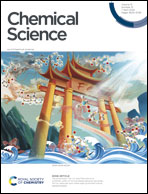Three-component dicarbofunctionalization of allylamines via nucleopalladation pathway: unlocking vicinal and geminal selectivity†
Abstract
A palladium(II)-catalyzed vicinal as well as geminal selective dicarbofunctionalization of allylamine embedded in a removable picolinamide auxiliary is developed by exploiting a nucleopalladation-triggered intermolecular three-component coupling reaction. The vicinal selectivity was accomplished by engaging allylamine, indoles, and aryl or styrenyl halides through a Pd(II)/Pd(IV) reaction manifold, while the two-fold coupling of allylamine and indoles via a Pd(II)/Pd(0) reaction modality resulted in geminal selectivity. The protocol is operationally simple, scalable, and offers two distinct types of products bearing functionalized tryptamine and bisindolyl frameworks in very high to excellent yields. The reaction features a wide substrate generality and also remains effective in the presence of various medicinally relevant scaffolds. Notably, this work represents the first example of nucleopalladation-guided intermolecular dicarbofunctionalization of allylamines.



 Please wait while we load your content...
Please wait while we load your content...